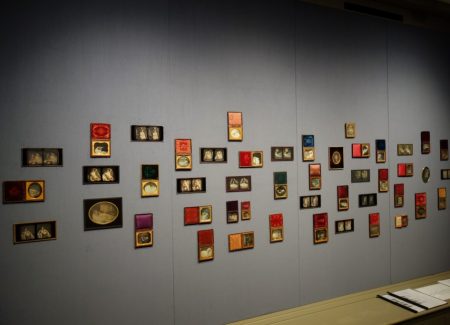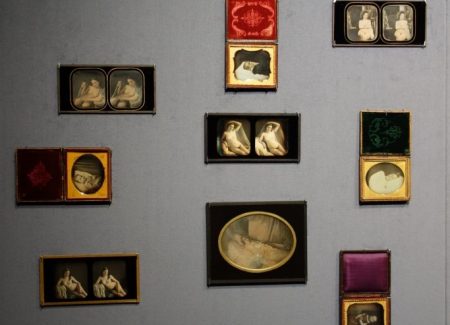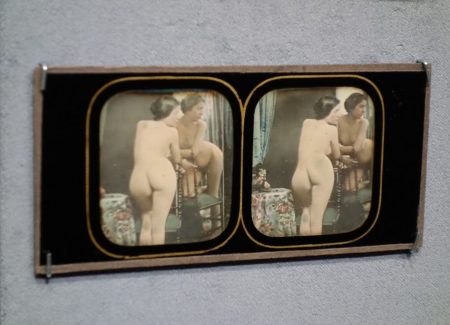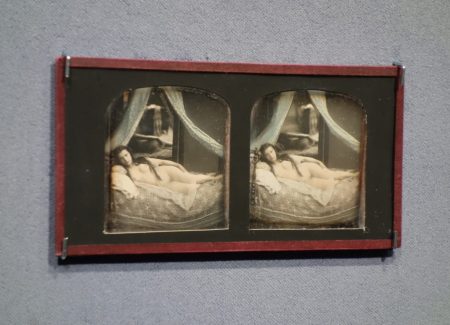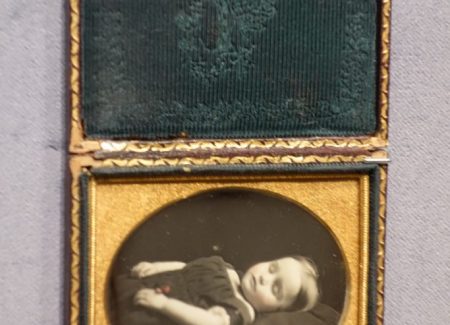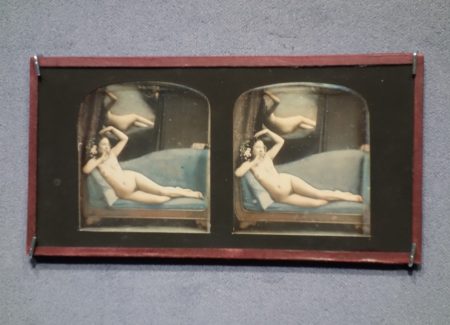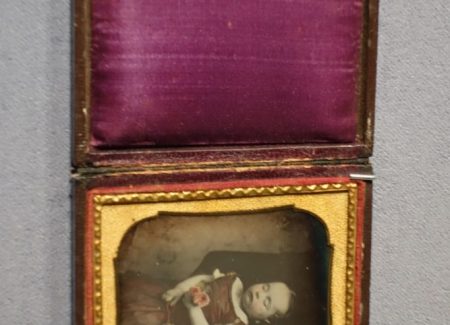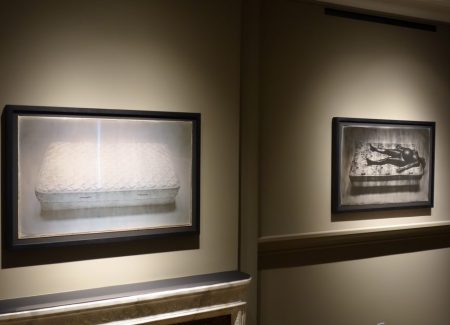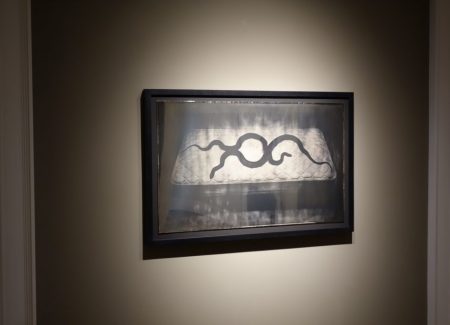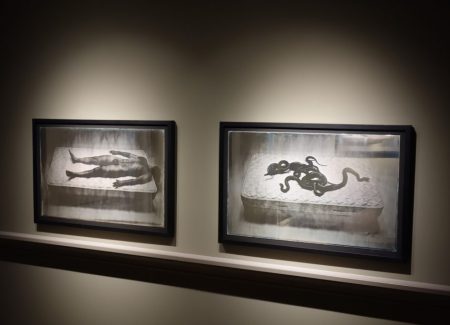JTF (just the facts): A paired show consisting of 47 vintage daguerreotypes by various makers, hung against a light blue fabric wall, and 6 contemporary daguerreotypes by Adam Fuss, displayed against cream colored walls in an adjacent space.
The vintage daguerreotypes on view were largely made by unknown European and American photographers in the 1840s and 1850s. Specific attributions or named artists include Bruno-Auguste Braquehais, Felix-Jacques Antoine Moulin, George C. Gilchrest, Thomas Faris, and Auguste Belloc. There are both single image and stereo daguerreotypes in the show, in sizes from sixteenth plate to half plate, some with hand tinting or coloring. These works were selected by Adam Fuss.
The Fuss works on view are modern daguerreotypes, made in 2010/2011. No size or edition information was provided on the checklist (we can assume the works are unique), but the images are among the largest daguerreotypes ever made, requiring specialized cameras and technical equipment. (Installation shots below.)
Comments/Context: The British photographer Adam Fuss has an art historical hypothesis to make. As laid out in an artist’s statement that accompanies this small show, Fuss argues that the arrival and presence of the daguerreotype in 1840s society had a strong influence on the British painters John Everett Millais, Dante Gabriel Rossetti, and William Holman Hunt, who would subsequently found the Pre-Raphaelite Brotherhood. He argues, based on visual evidence found in two paintings in particular, that the Pre-Raphaelites were grafting the precise detail of the daguerreotype (knowingly or unknowingly) onto their lush scenes influenced by early Italian painting. In both Millais’ Isabella and in his more famous Ophelia (now in the Tate Britain here), Fuss sees debts to photography. This conclusion forms the jumping off point for this thoughtful exhibition, which pairs a selection of vintage daguerreotypes with a recent group of Fuss’ own works in the same medium.
Fuss finds plenty of photographic footprints in Millais’ Ophelia. The scene of the young woman floating in the water seems to capture a particular instant, where a specific quality of light illuminates the central figure. He also sees plausible parallels in the shimmering surface of the brook in the painting, which echoes that of a silvery daguerreotype. And most notably, Ophelia’s horizontal pose is quite reminiscent of the aesthetic conventions of post mortem photography, especially in the blossoms that linger near her hands like a fallen bouquet.
Fuss’ selections of post mortem daguerreotypes from the same time period drive home his point with surprising clarity. Many young children in patterned dresses lie quietly on clean sheets, the essence of eternal repose on their faces. Even older men and women share the same beatific eyes-closed expression, as if they were tenderly floating off to a better place. Hand coloring was often added to give cheeks a pink hue or to add a splash of color to a handful of flowers, furthering the overall mood of gentle innocence. It’s not at all hard to imagine Millais drawing on these kinds of images when he was laying out his own painting.
Fuss also sees a simmering kind of latent sexual tension in Ophelia, casting viewers as voyeurs looking in on an intimately sensual scene. He ties this mood to the prevalence of erotic daguerreotypes during the same period, and provides a sampler of these kinds of images, interleaved with the death studies. Of course, daguerreotypes delivered a crispness of detail that was unprecedented, and so private nude imagery was an obvious subject, ranging from the demure to the explicit. The works here run that entire spectrum, the female nude often surrounded by a symbolic fruit basket, a songbird, or a mirror, with lush fabrics and reclining poses filling out the seductive tableaux.
Fuss’ own works in contemporary daguerreotypes return to this passionate duality of sex and death. Unlike the formal beds and chaises of the earlier daguerreotypes, Fuss has pared down his scene to the simplicity of an unsheeted mattress, which acts like a stage for his various actors. Full body nudes (some painted black) lie like corpses, while tangles of black snakes writhe and squirm in menacing piles. Seen in the context of his adjacent selections, the borrowed symbolism and aesthetic connections seem much clearer – his bodies are both boldly naked and a strangely inert and his snakes continually oscillate between seduction and repulsion (the Eden story never far from top of mind).
What’s intriguing about this exhibit is that we don’t have to guess about the exchange of ideas – we have an artist letting us into his thought process and allowing us to understand his influences as he sees them himself. Not only is Fuss proving himself to be a careful study of the overlooked corners his own medium, he’s also providing links back to the history of art in Britain, binding the past and present with mindful attention. In this case, context is what makes the show work – seen together, this sampler of daguerreotypes clicks right into place, the important elements of the 19th century works enriching our appreciation of the 21st century ones.
Collector’s POV: The works in this show are priced as follows. The vintage daguerreotypes range in price from $600 to $50000, with many on loan and therefore NFS. The Adam Fuss works are priced at $60000 each. Fuss’ images have become more consistently available in the secondary markets in the past five years or so, with prices ranging from roughly $2000 to $110000.
